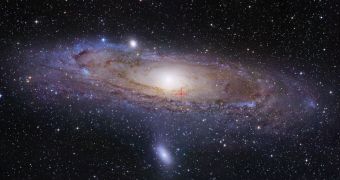Despite their name and what popular culture tells you about them, black holes are actually some of the brightest sources of light in the Universe. Granted, not the black holes themselves, but the matter that is heated to extremes as it falls inescapably towards the black hole.
The supermassive black holes (SMBH) that occupy the center of most galaxies gobble up huge amounts of matter and shoot off radiation in the process, particularly in the X-ray and radio spectrum. These objects are called quasars.
Smaller black holes, i.e. stellar mass black holes which are only several times heavier than our Sun as opposed to millions of times heavier like SMBHs, can also generate radiation like this, but since they're much smaller the effect is much harder to spot.
To date, only four of these microquasars have been discovered, all in our galaxy. Now though, researchers found the first microquasar outside of the Milky Way, 2.5 million light years away in our neighboring Andromeda.
The object, which has been labeled XMMU J004243.6+412519, was discovered by the XMM-Newton X-ray space observatory. NASA's Swift, which is designed to look for gamma ray bursts, and Chandra, an X-ray telescope, confirmed the discovery and gathered more data.
Finally, radio telescopes, the Very Large Array and the Very Long Baseline Array in New Mexico along with the Arcminute Microkelvin Imager Large Array in the UK, also observed the microquasar.
The object is an ultraluminous X-ray source, like many others that have been discovered. The problem has been in deciding the cause of these phenomena, stellar mass black holes, or relatively dormant massive black holes, or something else entirely.
In this case, scientists are convinced that it is a small black hole, the giveaway was its radio signature. The level of radio light coming from the source dropped very rapidly, halving in just 30 minutes, indicating that it can't be any bigger than the distance between the Sun and Jupiter.
Astronomers now believe that the source of many of the other ultraluminous X-ray sources is a regular sized black hole. The discovery is published in the journal Nature.
What's interesting is that, despite the fact that this microquasar is the farthest ever discovered, it's actually the easiest to study as its view isn't blocked by gas or dust clouds, like is the case with microquasars in our own galaxy.

 14 DAY TRIAL //
14 DAY TRIAL //